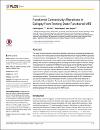Functional connectivity alterations in epilepsy from resting-state functional MRI
Abstract
The study of functional brain connectivity alterations induced by neurological disorders and their analysis from resting state functional Magnetic Resonance Imaging (rfMRI) is generally considered to be a challenging task. The main challenge lies in determining and interpreting the large-scale connectivity of brain regions when studying neurological disorders such as epilepsy. We tackle this challenging task by studying the cortical region connectivity using a novel approach for clustering the rfMRI time series signals and by identifying discriminant functional connections using a novel difference statistic measure. The proposed approach is then used in conjunction with the difference statistic to conduct automatic classification experiments for epileptic and healthy subjects using the rfMRI data. Our results show that the proposed difference statistic measure has the potential to extract promising discriminant neuroimaging markers. The extracted neuroimaging markers yield 93.08% classification accuracy on unseen data as compared to 80.20% accuracy on the same dataset by a recent state-of-the-art algorithm. The results demonstrate that for epilepsy the proposed approach confirms known functional connectivity alterations between cortical regions, reveals some new connectivity alterations, suggests potential neuroimaging markers, and predicts epilepsy with high accuracy from rfMRI scans.
Collections
- Computer Science & Engineering [2427 items ]
Related items
Showing items related by title, author, creator and subject.
-
EEG-based automatic epilepsy diagnosis using the instantaneous frequency with sub-band energies
Fani, Mohammad; Azemi, Ghasem; Boashash, Boualem ( IEEE , 2011 , Conference)This paper presents a novel approach for classifying the electroencephalogram (EEG) signals as normal or abnormal. This method uses features derived from the instantaneous frequency (IF) and energies of EEG signals in ... -
The differential effects of eicosapentaenoic acid (EPA) and docosahexaenoic acid (DHA) on seizure frequency in patients with drug-resistant epilepsy - A randomized, double-blind, placebo-controlled trial
Ibrahim, Fatma A S; Ghebremeskel, Kebreab; Abdel-Rahman, Manar E; Ahmed, Amar A M; Mohmed, Inaam M; Osman, Ghada; Elseed, Maha; Hamed, Ahlam; Rabinowicz, Adrian L; Salih, Mohamed A M; Elbashir, Mustafa I; Daak, Ahmed A... more authors ... less authors ( Elsevier , 2018 , Article)The omega-3 (n-3) fatty acids, eicosapentaenoic acid (EPA) and docosahexaenoic acid (DHA), are known to play an important role in maintenance and modulation of neuronal functions. There is evidence that omega-3 fatty acids ... -
The differential effects of eicosapentaenoic acid (EPA) and docosahexaenoic acid (DHA) on seizure frequency in patients with drug-resistant epilepsy — A randomized, double-blind, placebo-controlled trial
Ibrahim, Fatma A.S.; Ghebremeskel, Kebreab; Abdel-Rahman, Manar E.; Ahmed, Amar A.M.; Mohmed, Inaam M.; Osman, Ghada; Elseed, Maha; Hamed, Ahlam; Rabinowicz, Adrian L.; Salih, Mohamed A.M.; Elbashir, Mustafa I.; Daak, Ahmed A.... more authors ... less authors ( Academic Press Inc. , 2018 , Article)Objectives The omega-3 (n − 3) fatty acids, eicosapentaenoic acid (EPA) and docosahexaenoic acid (DHA), are known to play an important role in maintenance and modulation of neuronal functions. There is evidence that omega-3 ...


